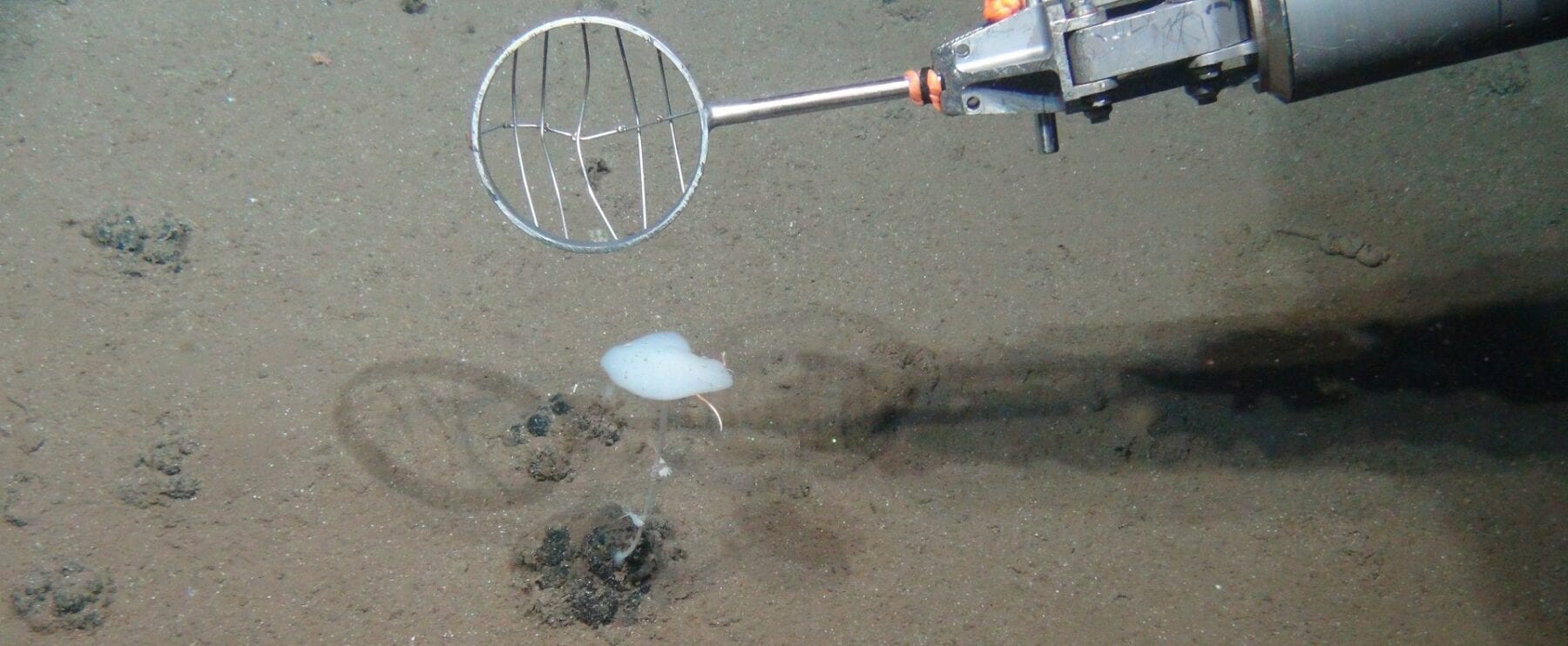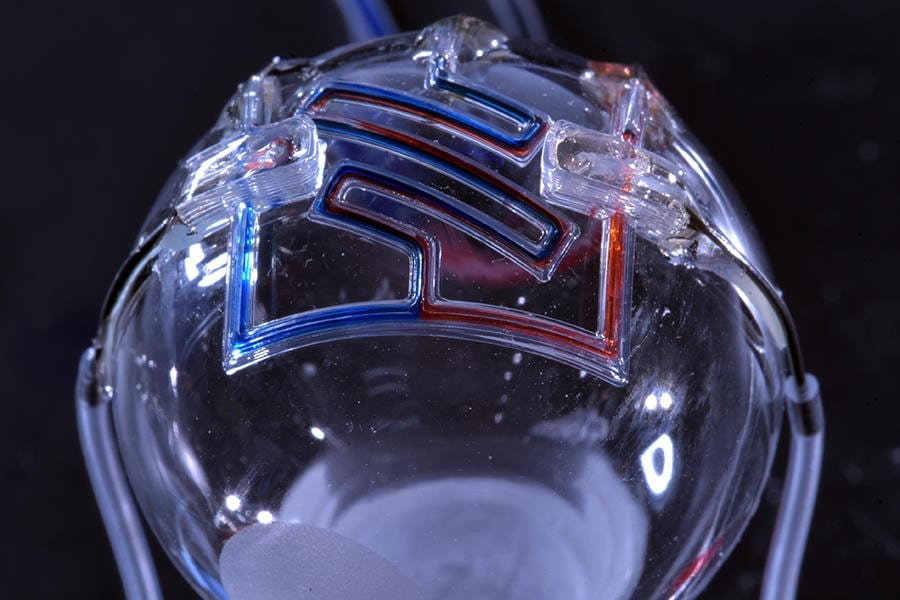
Sampling in the DISCOL area. Some larger animals recover faster than microbes. However, especially organisms living attached to manganese nodules, such as this stalked sponge, might be very vulnerable. (Credit: ROV-Team/GEOMAR)
Especially the microbial part of the carbon cycle is affected
Deep-seabed mining is considered a way to address the increasing need of rare metals. However, the environmental impacts are considered to be substantial but remain largely unknown and clear regulatory standards are lacking. Researchers at the Max Planck Institute for Marine Microbiology in Bremen, Germany, together with colleagues from The Netherlands, Belgium, Portugal, Germany and the UK, now describe that mining-related disturbances have a long-term impact on carbon flow and the microbial loop at the deep seafloor. They present their results in the journal Progress in Oceanography.
The deep sea is far away and hard to envision. If imagined it seems like a cold and hostile place. However, this remote habitat is directly connected to our lives, as it forms an important part of the global carbon cycle. Also, the deep seafloor is, in many places, covered with polymetallic nodules and crusts that arouse economic interest. There is a lack of clear standards to regulate their mining and set binding thresholds for the impact on the organisms living in affected areas.
Mining can reduce microbial carbon cycling, while animals are less affected
An international team of scientists around Tanja Stratmann from the Max Planck Institute for Marine Microbiology in Bremen, Germany, and Utrecht University, the Netherlands, and Daniëlle de Jonge from Heriot-Watt University in Edinburgh, Scotland, has investigated the food web of the deep seafloor to see how it is affected by disturbances such as those caused by mining activities.
For this, the scientists travelled to the so-called DISCOL area in the tropical East Pacific, about 3000 kilometres off the coast of Peru. Back in 1989, German researchers had simulated mining-related disturbances in this manganese nodule field, 4000 metres under the surface of the ocean, by ploughing a 3.5 km wide area of seabed with a plough-harrow. “Even 26 years after the disturbance, the plough tracks are still there”, Stratmann described the site. Previous studies had shown that microbial abundance and density had undergone lasting changes in this area. “Now we wanted to find out what that meant for carbon cycling and the food web of this deep ocean habitat.”
“We looked at all different ecosystem components and on all levels, trying to find out how they work together as a team”, de Jonge explained who carried out the project as part of her Master’s Thesis at the NIOZ Royal Netherlands Institute for Sea Research and the University of Groningen, The Netherlands. The scientists quantified carbon fluxes between living and non-living compartments of the ecosystem and summed them up as a measure of the “ecological size” of the system.
They found significant long-term effects of the 1989 mining simulation experiment. The total throughput of carbon in the ecosystem was significantly reduced. “Especially the microbial part of the food web was heavily affected, much more than we expected”, said Stratmann. “Microbes are known for their fast growth rates, so you’d expect them to recover quickly. However, we found that carbon cycling in the so-called microbial loop was reduced by more than one third.”
The impact of the simulated mining activity on higher organisms was more variable. “Some animals seemed to do fine, others were still recovering from the disturbance. The diversity of the system was thus reduced”, said de Jonge. “Overall, carbon flow in this part of the food web was similar to or even higher than in unaffected areas.”

Polymetallic nodules and crusts cover many thousands of square kilometres of the world’s deep-sea floor. They contain mainly manganese and iron, but also the valuable metals nickel, cobalt and copper as well as some of the high-tech metals of the rare earths. Since these resources could become scarce on land in the future – for example, due to future needs for batteries, electromobility and digital technologies – marine deposits are economically very interesting. To date, there is no market-ready technology for deep-sea mining. However, it is already clear that interventions in the seabed have a massive and lasting impact on the affected areas. Studies have shown that many sessile inhabitants of the surface of the seafloor depend on the nodules as a substrate, and are still absent decades after a disturbance in the ecosystem. Also, effects on animals living in the seabed have been proven.
A mined seafloor might be more vulnerable to climate change
The simulated mining resulted in a shift in carbon sources for animals. Usually, small fauna feed on detritus and bacteria in the seafloor. However, in the disturbed areas, where bacterial densities were reduced, the fauna ate more detritus. The possible consequences of this will be part of de Jonge’s PhD Thesis, which she just started. “Future climate scenarios predict a decrease of the amount and quality of detritus reaching the seafloor. Thus this shift in diet will be especially interesting to investigate in view of climate change”, she looks forward to the upcoming work.
“You also have to consider that the disturbance caused by real deep-seabed mining will be much heavier than the one we’re looking at here”, she added. “Depending on the technology, it will probably remove the uppermost 15 centimeters of the sediment over a much larger area, thus multiplying the effect and substantially increasing recovery times.”
The Latest Updates from Bing News & Google News
Go deeper with Bing News on:
Deep-seabed mining
- Pacific news in brief for April 25
A round-up of news in brief from around the region, including drug peddlers in Fiji using school students to transport drugs.
- From the coast to the deep sea, changing oxygen levels affect marine life in different ways
Earth's atmosphere maintains a constant level of oxygen, whether it is a wintry, rainy day or hot summer. Across the ocean, oxygen concentrations vary enormously between different places and over time ...
- Navigating the depths
Helen Beatty Partner Leo Shaw Senior Associate and Thomas Papworth Senior Associate at Herbert Smith Freehills LLP discuss the regulation and funding of deep sea mining ...
- Scientist calls out problematic 'climate solution' with potential for severe ocean damage: 'The issues far outweigh the benefits'
The fate of deep sea mining hangs in the balance. Scientist calls out problematic 'climate solution' with potential for severe ocean damage: 'The issues far outweigh the benefits' first appeared on ...
- Activists stage metal concert to sound of deep sea machinery outside London summit
CLIMATE activist group Ocean Rebellion staged a heavy metal concert outside the Deep Sea Mining Summit in London’s Canary Wharf on Wednesday. Recently, the UN International Seabed Authority awarded ...
Go deeper with Google Headlines on:
Deep-seabed mining
[google_news title=”” keyword=”deep-seabed mining” num_posts=”5″ blurb_length=”0″ show_thumb=”left”]
Go deeper with Bing News on:
Seafloor food web
- Bangladesh Children Sweat at Home as Heatwave Shuts Schools
Classes are canceled across Bangladesh due to searing heat, but high school student Mohua Akter Nur found the soaring temperatures at home left her in no state for homework. Millions of pupils were ...
- Philippine Settlement Submerged by Dam Reappears Due to Drought
A centuries-old settlement submerged by the construction of a dam in the northern Philippines in the 1970s has reappeared as water levels drop due to a drought affecting swathes of the country. The ...
- Swipe card found in Antarctica 13 years after being lost in Wellington
The story starts in 2003, when David McCaw lost the card which gave him access to the Wellington Town Hall and Michael Fowler Centre after his car was broken into. "My briefcase was sitting in the ...
- Secrets of the Octopus takes us inside the world of these “aliens on Earth”
Secrets of the Octopus is narrated by Paul Rudd. Per the official synopsis: ...
- Real Video of a Sea Cucumber Eating?
To identify the species in the video, Snopes spoke with Rich Mooi, an invertebrate zoology curator at the California Academy of Sciences. He confirmed that the clip indeed showed a sea cucumber ...
Go deeper with Google Headlines on:
Seafloor food web
[google_news title=”” keyword=”seafloor food web” num_posts=”5″ blurb_length=”0″ show_thumb=”left”]










